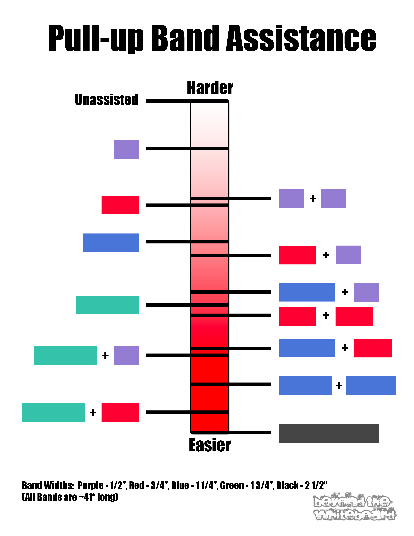The Assisted Pull Up
Oh man. If there's one skill everyone at the gym wants to RX, it's pull ups. Why? Because they're totally bad ass, that's why. Have you ever watched an action film and NOT seen the protagonist bust out pull ups during their Time-To-Turn-Into-A-Bad-Ass training montage? Didn't think so.
There's a pretty even split in my box between who "has" them and who doesn't. For those who don't, like me, assistance bands help us get the reps needed for the typical WOD. This is the generally accepted sub for the RX, although sometimes a coach will sub ring rows instead since they work the same muscle group.
A look at the different types of pull up, including our friend the Assisted or Banded Pull Up.
Assisted Ain't No Sissy Pull Up
One little pull up. Can't be that hard. Well, it is. Consider the legitimately damning physics of it— unlike in rowing or power lifting, here more mass does not equal more power. More mass means the more you have to lift to get your chin above the bar. Additionally, the longer your arms, the greater the distance you've got to cover. Man or woman, if you're short and light you've got an advantage here.
What a grim reality. But then someone gets your foot into a band and you're all, HOLY SHIT I'm doing a pull up! I'm all for equipment that replaces dread with a taste of success. And even with the help there's still plenty of work ahead of you.
What Band Do I Start With?
If you haven't done much conditioning work (ever or lately), you'll likely need to start with one of the thicker bands (black or green).
The thicker the band, the more resistance it has, creating tension that gets you out of the bottom of your pull up, while at the top you're on your own.
What's The Progression Between Each Band?
Ever see someone at the gym fooling around with multiple bands? They're not being equipment hoarders. They're fine-tuning the level of assistance needed for their strength.
The folks at Beyond The Whiteboard put this handy chart together to help you decode which band/combo of bands will give you a decreasing amount of assistance. You'll see that there are lots of ways to double up or combine bands to keep you progressing even between band colors. Getting "stuck" on a band forever is frustrating. Use this chart and you'll come unstuck a lot faster.
When Do I Graduate To A Lighter Band?
While the recommendation might differ from coach to coach and athlete to athlete, if you can do 2 - 3 unbroken sets of 8-10 on your current band, or you just have a sneaking suspicion that you're breezing through a pull-up WOD a little too easily, it's time to give a lighter one a try. Fear of testing it during a pressure cooker WOD? Get to the gym a few minutes before class to test it out, or do an open gym to focus on your pull up specifically.
If you're impatient like me, make the switch during your next pull up WOD but have a drop down plan. Today I decided to go from blue to red in a 2RFT WOD that included 25 pull-ups, rowing, wall balls and double unders. My arms were toast after the first set of 25, and 2 reps into the second set I needed to drop down and add a purple band I also had strapped to the bar, ready to save me. Even with the help, my shoulders protested and the reps were hard to get. But I did get a sense of where I'm at in the band spectrum. A WOD with big sets of pull-ups? Still going to need 2 bands. A WOD with sets of 12 and under? I'd go red and battle it out.
Is It Band Or Bust?
The band isn't everyone's preferred training method, and there are certainly separate schools of thought on the proper way to progress. Check out some tips from Mark Sisson:
Biggest tip is to train this consistently. If you want your pull up badly, waiting until pull ups show up in a WOD is a slow road. Now I need to listen to my own advice. RX pull up I'm coming for you in 2014!
